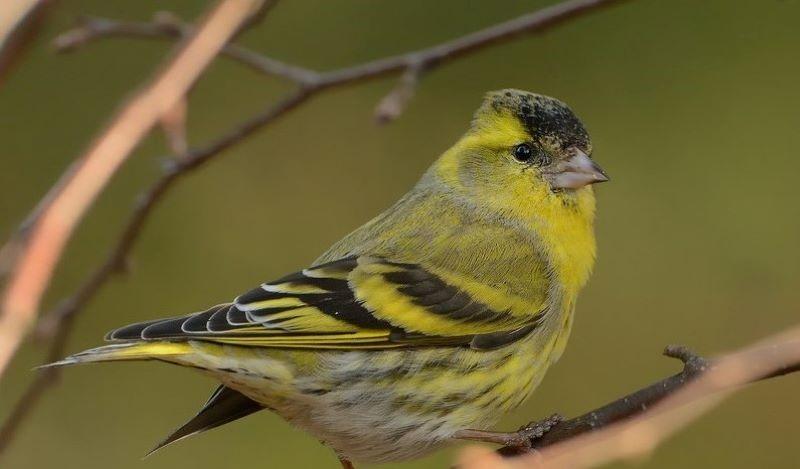
8 winter birds to spot in the Forest
Our first year of bird ringing in the Forest saw birds in their thousands recorded, including several species on the Red and Amber List for Conservation Concern, giving us a greater picture of our birdlife in the Heart of England Forest. Here's our list of 8 birds to spot out on walks in the Forest this winter including the eye-catching goldfinch, the lively siskin, and the characterful stonechat.
Woodcock
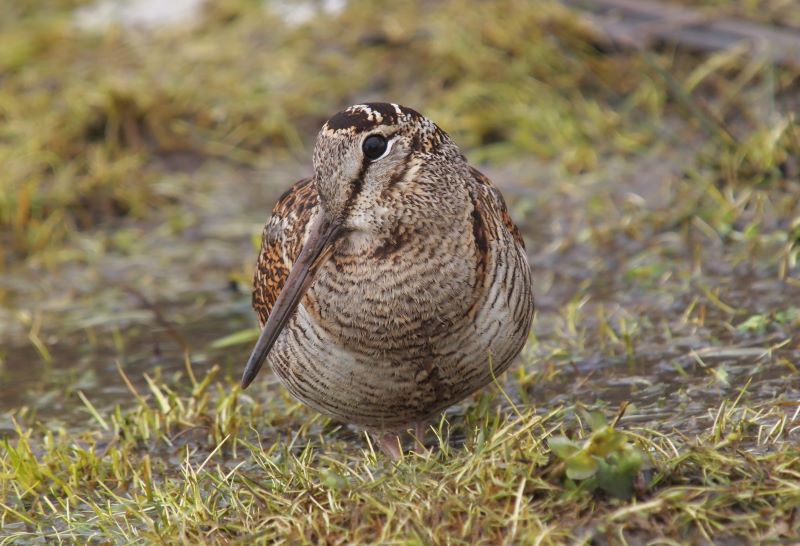
The woodcock is a thick-set, pigeon-sized bird with a very long bill. It is found mainly in woodlands and is most active between dusk and dawn. During daylight hours the woodcock likes to hunker down on the Forest floor where its beautiful, multi-hued, brown plumage makes it almost impossible to spot unless it is disturbed. The resident UK population has been declining in recent decades and it is now a Red List species of Conservation Concern, but in the autumn home birds are joined by an influx from the Continent (mainly northern Europe and Russia) swelling the population to well over a million birds.
Woodcock have been hunted and eaten since Roman times. The cocker spaniel is named after the bird, and the dogs were originally bred to help with the hunt. The woodcock’s pin feathers (a special type of wing feather) were used widely for various purposes including by artists for particularly fine work and by Rolls Royce for drawing the gold stripe down the side of their cars. This autumn and winter you may be lucky and flush out a woodcock on one of your forays into the Forest.
Lesser Redpoll

Weighing as little as 10 grams (1/3 ounce), the lesser redpoll is one of Britain’s smallest finches, only slightly bigger than a blue tit. It is a streaky and brown bird with patches of red on its head and sometimes its breast, and a yellowish bill. They breed in woodlands but will also visit gardens. Flocks can sometimes be seen close up feeding in birch trees, with the nearest birds almost in touching distance. At other times flocks can be quite flighty rising as a big group then scattering in all directions when a predator is sensed.
Birch seed is redpoll’s favourite food and a poor crop in winter can lead many British birds to migrate to the continent in search of better supplies. Lesser redpolls are on the Red List for Conservation Concern in the UK, so we hope the planting of many more birch trees in the Forest will help them prosper in the south midlands.
Siskin

A member of the finch family, the siskin is a lively, acrobatic bird often seen hanging upside down as it feeds on the seeds of alder. The brightly coloured male has a yellow-green streaky body and a black crown and bib. The female, though more muted in colour, also shows yellow, green and black markings, but has no black on its head. Slightly smaller than a greenfinch, siskins are very social birds often forming small flocks and even teaming up with another finch, the lesser redpoll, in the autumn and winter months.
Before the 1960s siskins were a rare sight gardens, but they have since become regular visitors to garden feeding stations in many parts of the country. Siskins are fairly trusting of humans and can often be observed at quite close quarters. So, with plenty of birch and alder growing in the Forest, look out for these energetic and engaging birds during your winter walks.
Goldfinch

Flocks of anything from 10 – 100+ goldfinch can be seen across the Forest in winter searching for food. Look out for its bright red crown, golden back and bright yellow wings.
They can be spotted feeding on thistle and teasels in our young plantations and are specialist seed feeders, pulling them out with their long, fine beaks. The collective noun for a group of goldfinches is a ‘charm’, which is fitting for these very pretty birds.
Brambling
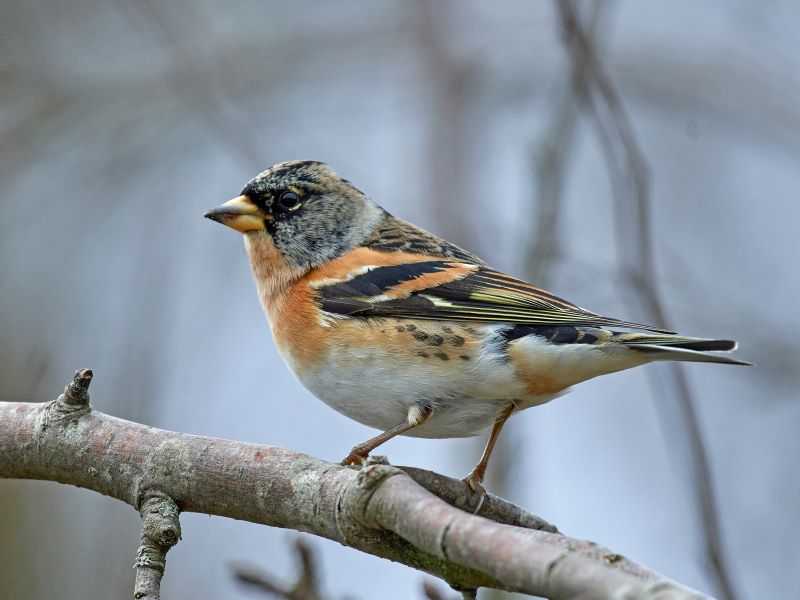
Mainly a winter visitor, the brambling is a chaffinch-sized bird with distinctive orange-buff colouring on its breast and wings. Its favourite food is the fruit of the beech tree (known as mast), and in winter many hundreds of thousands of birds can travel from their native Scandinavia to take advantage of this feeding bonanza in UK woods and forests.
Bramblings are gregarious birds and often form large flocks, sometimes with other finches, their tortoiseshell colours providing a perfect camouflage as they feed on the leaf-covered woodland floor. If supplies of beechmast become scarce, they have been known to venture into gardens, and if they do pay a visit, they would be a fine addition to a garden bird list!
Teal
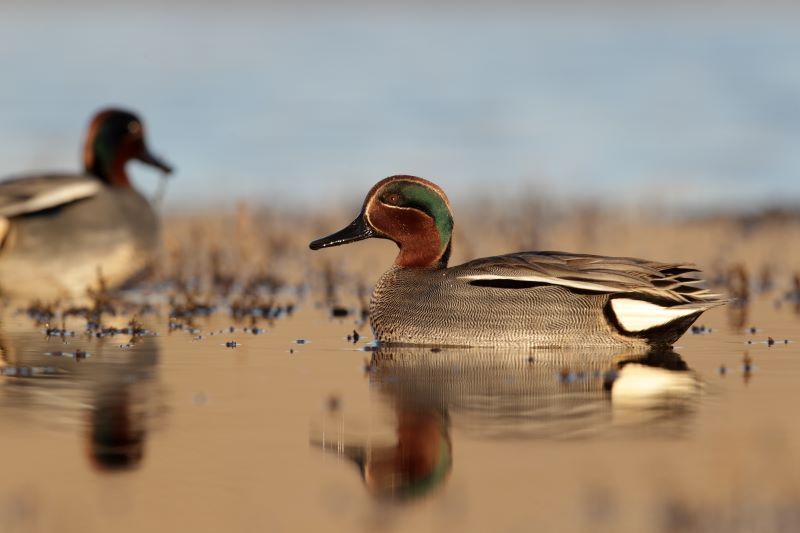
With their distinctive chestnut-coloured heads with broad green eye-patches, male teals are small, attractive, dabbling ducks. Females are mottled brown. In winter, they often make use of the wetland areas in the Forest and may well have travelled from as far away as the Baltic or Siberia. They feed mainly on the surface rather than dive for food.
They have been popular with wildfowlers for centuries and are sometimes referred to as the ‘half-bird’ or ‘half-duck’ on account of their diminutive size, though the teal is in fact closer to a third or even a quarter the weight of a mallard. Teal are known collectively as a ‘spring’ for the way a flock can rise almost vertically from the water if startled.
The name teal dates from at least the 13th century and although various spellings have been used in the last 800 years, the bird is unusual in never having been known by any other name. The UK is home to a significant percentage of the north-western European wintering population making it an Amber List species.
Stonechat
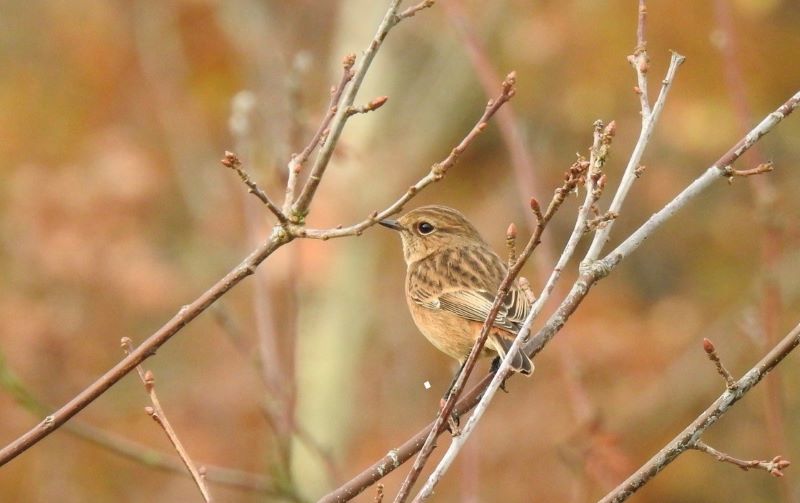
One of our few resident insect eaters, the characterful stonechat is a robin-sized bird that breeds mainly in the south and west but is much more widespread in the winter months. It can be seen flicking its wings as it perches on the top of small trees, bushes and thistles, making it quite easy to spot. The male has a striking black head with white around the side of its neck, orange-red breast, and a mottled brown back. Females are similar but lack the male’s black head.
Their name is derived from the loud sharp call they make which sounds like two stones being knocked together. In old Scottish lore the stonechat was said to possess occult powers! This characterful bird can pop up all over the Forest during winter.
Thanks to volunteer Richard for this photo of a female stonechat at Morgrove Coppice.
Merlin
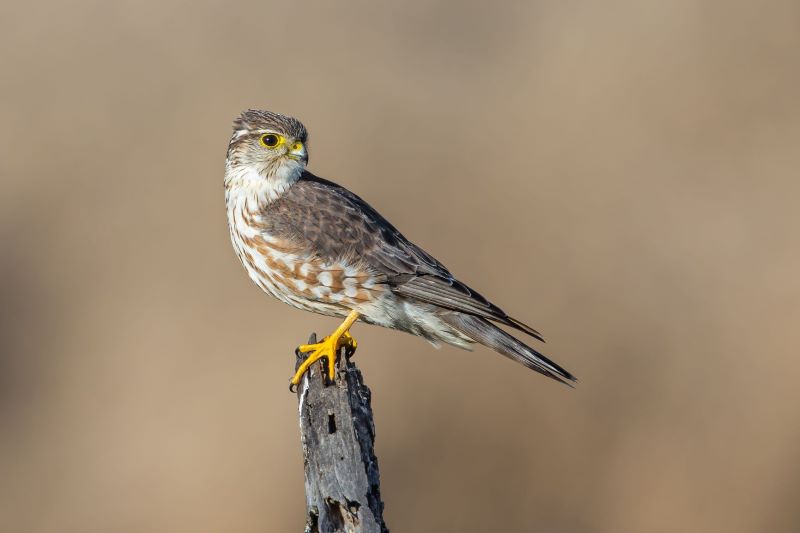
The UK’s smallest breeding falcon, a male merlin, traditionally known as a jack, can be shorter than a mistle thrush, while the female is slightly larger. Small it may be, but the merlin is an agile and ferocious hunter and can catch prey in the air up to four times its own weight. The male has striking blue-grey upper parts with a black-streaked rusty colouring below; females are dark brown above with similar black streaking below.
Merlins breed on upland moors but come down to inland lowland and coastal areas in the winter, where numbers are swelled by birds from Iceland. In the past they were a popular falconer’s bird, particularly for ladies on account of their small size – merlins were used by both Mary Queen of Scots and Catherine the Great.
They suffered a population crash in the late 20th century and, although numbers have been recovering, merlins are still on the Red List. You would be very lucky to see one, but these small elusive predators have been seen in the Forest at Sheriffs Lench and Newnham, so you never know, you might catch a glimpse of one this winter.
Support your local birdlife
Take part in the RSPB’s Big Garden Birdwatch on the 29th to 31st January to discover the birds on your doorstep. You can help wildlife thrive in the Forest by becoming a Friend of the Forest.



